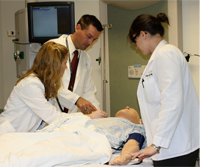VHA SimLEARN
Next generation of providers training to recognize and treat delirium

By Jeffrey Cluver, M.D. Ralph H. Johnson VA Medical Center
CHARLESTON, SC – The Ralph H. Johnson VA Medical Center here is closely affiliated with the Medical University of South Carolina, and rotates an average of 1,200 trainees each year through a variety of clinical services. In the course of their clinical rotations, many of the students and residents will encounter and treat Veterans who have delirium.
As a staff psychiatrist in the substance abuse treatment clinic, I consulted on a number of cases of delirium due to alcohol withdrawal. It always struck me that trainees, physicians, nurses and other staff always had a variety of responses to, and misconceptions about, patients with delirium. Therefore, I began incorporating a talk on the topic for all of the residents and students who rotated through the substance abuse service. When our affiliate opened the doors to a state-of-the-art simulation center, a call for modules went out across the campus. After some brief discussions with the local simulation experts, I decided that delirium was fair game for a new module for the center.
The modules initially targeted medical students. Students worked in small groups (we have found that a group of three students is optimal), and they are handed a chart and told to see a patient who has been acting "odd," according to the nurse.
The students walk into one of our simulation rooms and encounter a SimMan® who is babbling incoherently, shouting abrasively, or perhaps even acting somewhat normally. If the patient is approached systematically, the students soon realize that the patient is confused, and they are then faced with trying to determine the underlying cause of the delirium while they stabilize the patient. To add realism, and some excitement, the patient will become increasingly agitated if he is not treated appropriately. Additionally, if the students do not manage the case effectively the patient may have a seizure, develop an arrhythmia or become unresponsive.
There are several modules with different underlying causes of delirium, including alcohol withdrawal, neuroleptic malignant syndrome and pneumonia. The modules have been very well received, and we have been gathering survey data as part of an institutional review board-approved protocol. An added benefit has been the development of our psychiatric residents as facilitators for the modules. The residents who participate as facilitators have commented that they feel more confident in their ability to recognize and treat delirium as a result of their participation as teachers.



















